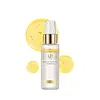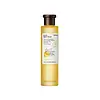What's inside
What's inside
 Key Ingredients
Key Ingredients

 Benefits
Benefits

 Concerns
Concerns

 Ingredients Side-by-side
Ingredients Side-by-side

Water
Skin ConditioningDipropylene Glycol
HumectantNeopentyl Glycol Diheptanoate
EmollientGlycereth-26
Humectant1,2-Hexanediol
Skin ConditioningNiacinamide
SmoothingHydroxyethyl Urea
HumectantPersea Gratissima Oil
Skin ConditioningButylene Glycol
HumectantBetaine
HumectantTuber Magnatum Extract
Skin ConditioningGlycerin
HumectantHelianthus Annuus Seed Oil
EmollientSorbitol
HumectantDipotassium Glycyrrhizate
HumectantDisodium EDTA
Tocopheryl Acetate
AntioxidantAdenosine
Skin ConditioningBifida Ferment Lysate
Skin ConditioningGlycine Soja Oil
EmollientSodium Palmitoyl Proline
Skin ConditioningArginine
MaskingBellis Perennis Flower Extract
Skin ConditioningCarbomer
Emulsion StabilisingFreesia Refracta Extract
Skin ConditioningHouttuynia Cordata Extract
Skin ConditioningLeontopodium Alpinum Extract
Skin ConditioningLilium Candidum Flower Extract
Skin ConditioningMorus Alba Bark Extract
Skin ConditioningNelumbo Nucifera Flower Extract
Skin ConditioningPanax Ginseng Root Extract
EmollientSaussurea Involucrata Extract
HumectantPotassium Sorbate
PreservativeAvena Sativa Kernel Extract
AbrasiveHydrolyzed Hyaluronic Acid
HumectantOcimum Basilicum Flower/Leaf/Stem Extract
TonicSalvia Hispanica Seed Extract
EmollientBixa Orellana Seed Oil
EmollientTocopherol
AntioxidantNymphaea Alba Flower Extract
Skin ConditioningParfum
MaskingLinalool
PerfumingHexyl Cinnamal
PerfumingLimonene
PerfumingCitronellol
PerfumingWater, Dipropylene Glycol, Neopentyl Glycol Diheptanoate, Glycereth-26, 1,2-Hexanediol, Niacinamide, Hydroxyethyl Urea, Persea Gratissima Oil, Butylene Glycol, Betaine, Tuber Magnatum Extract, Glycerin, Helianthus Annuus Seed Oil, Sorbitol, Dipotassium Glycyrrhizate, Disodium EDTA, Tocopheryl Acetate, Adenosine, Bifida Ferment Lysate, Glycine Soja Oil, Sodium Palmitoyl Proline, Arginine, Bellis Perennis Flower Extract, Carbomer, Freesia Refracta Extract, Houttuynia Cordata Extract, Leontopodium Alpinum Extract, Lilium Candidum Flower Extract, Morus Alba Bark Extract, Nelumbo Nucifera Flower Extract, Panax Ginseng Root Extract, Saussurea Involucrata Extract, Potassium Sorbate, Avena Sativa Kernel Extract, Hydrolyzed Hyaluronic Acid, Ocimum Basilicum Flower/Leaf/Stem Extract, Salvia Hispanica Seed Extract, Bixa Orellana Seed Oil, Tocopherol, Nymphaea Alba Flower Extract, Parfum, Linalool, Hexyl Cinnamal, Limonene, Citronellol
Citrus Junos Fruit Extract 93%
Skin ConditioningNiacinamide
Smoothing1,2-Hexanediol
Skin ConditioningPPG-13-Decyltetradeceth-24
EmulsifyingPolyglyceryl-10 Laurate
Skin ConditioningSodium Ascorbyl Phosphate
AntioxidantCitrus Aurantium Bergamia Fruit Oil
MaskingCitric Acid
BufferingSodium Citrate
BufferingCitrus Tangerina Peel Oil
MaskingDipotassium Glycyrrhizate
HumectantCaramel
Cosmetic ColorantJuniperus Mexicana Oil
MaskingCaprylic/Capric Triglyceride
MaskingDiacetyl Boldine
Skin ConditioningLimonene
PerfumingLinalool
PerfumingCitrus Junos Fruit Extract 93%, Niacinamide, 1,2-Hexanediol, PPG-13-Decyltetradeceth-24, Polyglyceryl-10 Laurate, Sodium Ascorbyl Phosphate, Citrus Aurantium Bergamia Fruit Oil, Citric Acid, Sodium Citrate, Citrus Tangerina Peel Oil, Dipotassium Glycyrrhizate, Caramel, Juniperus Mexicana Oil, Caprylic/Capric Triglyceride, Diacetyl Boldine, Limonene, Linalool
 Reviews
Reviews

Alternatives
Ingredients Explained
These ingredients are found in both products.
Ingredients higher up in an ingredient list are typically present in a larger amount.
1,2-Hexanediol is a synthetic liquid and another multi-functional powerhouse.
It is a:
- Humectant, drawing moisture into the skin
- Emollient, helping to soften skin
- Solvent, dispersing and stabilizing formulas
- Preservative booster, enhancing the antimicrobial activity of other preservatives
Dipotassium Glycyrrhizate comes from licorice root.
Extracts of licorice have demonstrated to have antibacterial, anti‐inflammatory, antiviral, antioxidant properties.
One component, glabridin, has extra potent antioxidant and soothing properties. It has also been found to block pigmentation from UVB rays in guinea pigs.
Licorice Root also contains a flavonoid. Flavonoids are a natural substance from in plants. Flavonoids also have antioxidant properties.
Another component, glycyrrhizin, has been found to have anti-inflammatory and antimicrobial benefits. This may make licorice root extract effective at treating acne. However, more research is needed to support this.
Liquiritin is one of the flavone compounds found in licorice. It has been found to help lighten skin by preventing tyrosinase from reacting with tyrosine. When the two react, protein is converted to melanin. Melanin is the substance in your body that gives your features pigmentation.
Licorice root is native to Southern Europe and Asia. It has been used in traditional Chinese medicine to help with respiratory issues.
Learn more about Dipotassium GlycyrrhizateLimonene is a fragrance that adds scent and taste to a formulation.
It's found in the peel oil of citrus fruits and other plants such as lavender and eucalyptus. The scent of limonene is generally described as "sweet citrus".
Limonene acts as an antioxidant, meaning it helps neutralize free radicals.
When exposed to air, oxidized limonene may sensitize the skin. Because of this, limonene is often avoided by people with sensitive skin.
The term 'fragrance' is not regulated in many countries. In many cases, it is up to the brand to define this term. For instance, many brands choose to label themselves as "fragrance-free" because they are not using synthetic fragrances. However, their products may still contain ingredients such as essential oils that are considered a fragrance.
Learn more about LimoneneLinalool is a fragrance and helps add scent to products. It's derived from common plants such as cinnamon, mint, citrus, and lavender.
Like Limonene, this ingredient oxidizes when exposed to air. Oxidized linalool can cause allergies and skin sensitivity.
This ingredient has a scent that is floral, spicy tropical, and citrus-like.
Learn more about LinaloolNiacinamide is a multitasking form of vitamin B3 that strengthens the skin barrier, reduces pores and dark spots, regulates oil, and improves signs of aging.
And the best part? It's gentle and well-tolerated by most skin types, including sensitive and reactive skin.
You might have heard of "niacin flush", or the reddening of skin that causes itchiness. Niacinamide has not been found to cause this.
In very rare cases, some individuals may not be able to tolerate niacinamide at all or experience an allergic reaction to it.
If you are experiencing flaking, irritation, and dryness with this ingredient, be sure to double check all your products as this ingredient can be found in all categories of skincare.
When incorporating niacinamide into your routine, look out for concentration amounts. Typically, 5% niacinamide provides benefits such as fading dark spots. However, if you have sensitive skin, it is better to begin with a smaller concentration.
When you apply niacinamide to your skin, your body converts it into nicotinamide adenine dinucleotide (NAD). NAD is an essential coenzyme that is already found in your cells as "fuel" and powers countless biological processes.
In your skin, NAD helps repair cell damage, produce new healthy cells, support collagen production, strengthen the skin barrier, and fight environmental stressors (like UV and pollution).
Our natural NAD levels start to decline with age, leading to slower skin repair, visible aging, and a weaker skin barrier. By providing your skin niacinamide, you're recharging your skin's NAD levels. This leads to stronger, healthier, and younger looking skin.
Another name for vitamin B3 is nicotinamide. This vitamin is water-soluble and our bodies don't store it. We obtain Vitamin B3 from either food or skincare. Meat, fish, wheat, yeast, and leafy greens contain vitamin B3.
The type of niacinamide used in skincare is synthetically created.
Learn more about Niacinamide